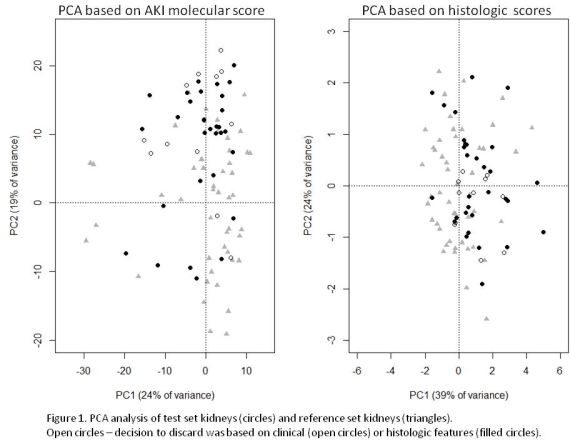Many Discarded Kidneys Are Similar to Kidneys Accepted for Transplantation as Judged by Their Histologic Lesions and Molecular AKI Scores.
1University of Alberta, Edmonton, Canada
2Necker Hospital, Paris, France
3University of Maryland, Baltimore.
Meeting: 2016 American Transplant Congress
Abstract number: 272
Keywords: Cadaveric organs, Gene expression, Kidney transplantation, Renal injury
Session Information
Session Name: Concurrent Session: Acute Kidney Injury and Recovery after Transplantation
Session Type: Concurrent Session
Date: Monday, June 13, 2016
Session Time: 4:30pm-6:00pm
 Presentation Time: 5:06pm-5:18pm
Presentation Time: 5:06pm-5:18pm
Location: Ballroom C
There is an increase in the number kidneys from older brain dead donors (DBD). Many are discarded based on conventional features (clinical or histology). Thus we asked whether the molecular AKI scores and histologic scores can demonstrate that some kidneys discarded by conventional features will be similar to kidneys accepted for transplantation.
Test set contained 43 pre-implantation core biopsies (Bx) from discarded kidneys of DBD donors, age>50yr. Decision to discard was based on histological or clinical features. The independent reference set contained 47 Bx from accepted DBD kidneys from donors >50yr. The molecular AKI score was based on the gene set of injury-repair response transcripts that were elevated in AKI and was analyzed by microarrays. The following histologic lesions were assessed – % of glomerulosclerosis (GS), fibrous intimal thickening (cv 0-3), fibrosis/atrophy (IFTA 0-3) and arterial hyalinosis (ah 0-3).
We compared the test set to the reference set by principal component analysis (PCA) using complete histo-molecular data. The 43 discarded kidneys from the test set were similarly distributed as the 47 accepted kidneys when the molecular AKI score was analyzed..
We then analyzed the similarity of discarded kidneys to accepted kidneys using the histology features i.e. % of GS, cv IFTA and ah scores, and donor age for each biopsy (Figure 1). The PCA based on these variables showed striking similarity of discarded kidneys: 34 discarded kidneys had similar positive PC1 scores to 19 accepted kidneys with positive PC1 scores. All kidneys with positive PC1 scores had more ah, cv and GS. However, there was no difference in histologic features within the PC1 score positive group between the discarded and accepted kidneys.
Thus by histology and molecular features the discarded kidneys in one center are similar to the kidneys accepted in another center. The current criteria for discarding kidneys based on conventional features, particularly histology, needs to be reassessed.
CITATION INFORMATION: Famulski K, Reeve J, Aubert O, Loupy A, Niderhaus S, Bromberg J, Halloran P. Many Discarded Kidneys Are Similar to Kidneys Accepted for Transplantation as Judged by Their Histologic Lesions and Molecular AKI Scores. Am J Transplant. 2016;16 (suppl 3).
To cite this abstract in AMA style:
Famulski K, Reeve J, Aubert O, Loupy A, Niderhaus S, Bromberg J, Halloran P. Many Discarded Kidneys Are Similar to Kidneys Accepted for Transplantation as Judged by Their Histologic Lesions and Molecular AKI Scores. [abstract]. Am J Transplant. 2016; 16 (suppl 3). https://atcmeetingabstracts.com/abstract/many-discarded-kidneys-are-similar-to-kidneys-accepted-for-transplantation-as-judged-by-their-histologic-lesions-and-molecular-aki-scores/. Accessed January 4, 2026.« Back to 2016 American Transplant Congress
